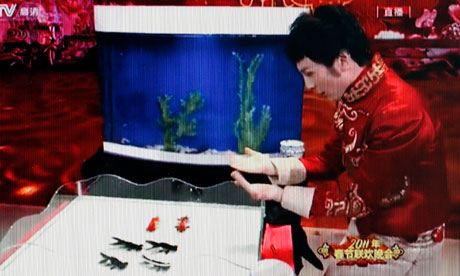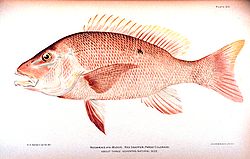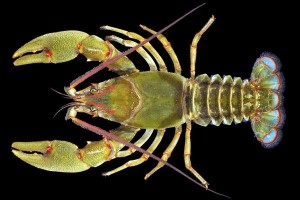Tag Archives: Fish
Native American tribes strive to save the lamprey
Lamprey used to be an important source of food for Native American tribes living along the northwestern coast of North America, and the fish was once upon a time harvested in ample amounts from rivers throughout the Columbia Basin, from Oregon to Canada.
Gold Nugget pleco and Mango pleco finally described by science
Two pleco species from the Xingu River drainage that are popular within the aquarium hobby have finally been scientifically described and given scientific names.
Will grey seals counteract cod recovery in the Baltic Sea?
Grey seals and cod used to be found in great abundance throughout the Baltic Sea, but today the seals are chiefly present in the northern parts of the sea while the cod is found in the south.
Hilton stops serving sailfish and marlin in Costa Rica
Four Hilton Worldwide hotels in Costa Rica have pledged to stop serving sailfish and marlin after entering into an agreement with the Billfish Foundation (TBF) and the Costa Rica Sport Fishing Federation (FECOPT).
China Releases 1.3 Billion Fish into Yangtze River
Last week, 1.3 billion fish were released into the Yangtze River by the Chinese Ministry of Agriculture (MOA). The release took place in the provinces of Jiangxi, Hubei, Hunan, Anhui and Jiangsu in the middle and lower reaches of the river.
Aquarium calamity – are you prepared?
Many pet owners purchase pet insurance for their dogs, cats, horses etcetera but have you ever thought about the insurance needs of your aquarium? While few insurance companies would let you take out a life insurance policy on a guppy or be willing to pay for goldfish surgery, there are other types of insurance that any aquarium owner should consider.
The insurance needs of an aquarium owner can be divided into two categories:
Insurance for the aquarium itself, including equipment and inhabitants
Insurance that covers damages caused by the aquarium, e.g. water damage to the floor and the apartment below you
Your aquariums, their contents, and any damage caused by them may or may not be covered by your homeowner’s or renter’s insurance. You need to check your specific policy to find out more – and don’t forget to read the small print. Many insurance policies have quite a comprehensive exclusion list and it is not unusual for all aquariums, or certain aquariums, to show up on this list. Your insurance company may for instance only be willing to pay for damages caused by an aquarium up to a certain amount of gallons, or only cover aquariums that live up to certain standards. It is also quite common for insurance policies not to cover the inhabitants (livestock) of the aquarium but everything else. Some insurance companies will consider plants and corals inhabitants, while others see them as decor.
If you build your own hobby aquariums this doesn’t necessarily disqualify them from being insured. However, most insurance companies have rules stipulating that only “professional quality” aquariums can be insured. This doesn’t mean that an aquarium has to be built by a professional to insured, only that it has to live up to the same level of quality as a professionally constructed tank. Naturally, this is an area where insurance companies and aquarium owners do not always see eye to eye.
Last but not least, it is common for insurance companies to have a notification limit. If for instance your policy has a $1 500 notification limit, you have to inform the insurance company about any possessions that are worth more than $1 500. If for instance your home is burglarized and you file a claim for a $2 000 necklace that got stolen, the insurance company may refuse to cover the necklace if you failed to notify them about you keeping such a precious piece of jewelery in your home. If you own an aquarium, keep in mind that if you file a claim for the entire aquarium you may hit this $1 500 ceiling even if the tank itself did not cost $1 500 to buy. As any fish owner knows, the dollars can keep piling up quite rapidly. You buy a $500 tank, you add some nice filters and a heater, you get some additional stuff along the way, and soon you’ve reached the notification limit without even realizing it. Take a closer look at your aquarium. Would you file a claim if it was destroyed? If yes, have you notified the insurance company about its value?
Hagfish absorb food directly through its skin

Hagfish
Hagfish, an elongated scavenger found on the bottom of the sea, is truly a weird and wonderful creature. A single fossil of hagfish shows that is has undergone little evolutionary change in the last 300 million years, and the hagfish is believed to the be oldest living connection to the first vertebrate. Its the Hagfish, an elongated scavenger found on the bottom of the sea, is truly a weird and wonderful creature. A single fossil of hagfish shows that is has undergone little evolutionary change in the last 300 million years, and the hagfish is believed to the be oldest living connection to the first vertebrate. Its eyespots can detect light but lacks both lens and extrinsic musculature, and is therefore believed to show a significant step in the evolution of more complex eyes. The hagfish is also famous for exuding vast amounts of a gel-like slime when threatened. An adult hagfish can secrete enough slime to turn a 20 litre (5 gallon) bucket of water into slime in a matter of minutes. When captured, e.g. by a human or predatory fish, it will tie itself in an overhand knot which gradually works its way from the head to the tail of the hagfish, scraping off the slime as it goes, thus freeing the hagfish from its captor and from the slime in one swift movement.
Hagfish eat dead and injured sea creatures and will borrow into the body cavity of a dead (or dying!) animal to devour it from within. Once its full, it can go several months without feeding again.
Now, a new study on hagfish caught near Vancouver Island in Canada has unveiled yet another remarkable fact about the hagfish – it seems as though this fish is actually able to eat with its skin and gills, i.e. absorb nutrients through its skin and gills instead of using its mouth.
A research team* headed by Chris Glover of the University of Canterbury in New Zealand and Bamfield Marine Sciences Center took skin and gill tissue from hagfish and tested the tissues’ absorption of two different amino acids.
“We wanted to start with a simple dissolved organic nutrient, and given the fact that the food source is a large decaying pile of protein, an amino acid seemed to be the best place to start,” says Glover.
When a hagfish has managed to burrow its way into a carcass, it will feed surrounded by a high concentration of dissolved nutrients, so being able to absorb food through more than just its mouth could come in handy.
The results of the study carried out by Glover and his colleges indicate that specific molecular mechanisms exist within the hagfish tissues to move the two tested amino acids into the body of the fish. When researchers increased the concentration of amino acids the tissue increased its absorption – but only up to a certain level.
“A quick and simple calculation suggests that the skin in particular may be capable of absorbing nutrients at levels equivalent to that of the digestive tract!”, says Glover.
There are quite a few invertebrates, including many mollusks and worms, that can absorb nutrients through their skin. But up until now, no vertebrates have been known to have this capacity. The hagfish may represent a transition between the feeding habits of aquatic invertebrates like mollusks and the more specialized digestive systems found in vertebrates. While some organisms exchange nutrients with the water around them in order to maintain their body fluid salt concentrations, the hagfish is – according to Glover – likely to transport amino acid molecules through its skin and gills exclusively to feed itself.
The paper “Adaptations to in situ feeding: novel nutrient acquisition pathways in an ancient vertebrate” has been published in the most recent issue of journal Proceedings of the Royal Society B: Biological Sciences.
* Chris N. Glover (http://www.biol.canterbury.ac.nz/people/glover.shtml) School of Biological Sciences, University of Canterbury, Christchurch, New Zealand Bamfield Marine Sciences Centre, Bamfield, British Columbia, Canada
Carol Bucking (no bio page available) Bamfield Marine Sciences Centre, Bamfield, British Columbia, Canada Department of Zoology, University of British Columbia, British Columbia, Canada
Chris M. Wood (http://www.biology.mcmaster.ca/faculty/wood/wood.htm) Bamfield Marine Sciences Centre, Bamfield, British Columbia, Canada Department of Biology, McMaster University, Ontario, Canada
Another case of animal cruelty against goldfish at a Chinese Gala
Yet another Chinese event is by many considered to be tainted with animal cruelty, and just as with the olympics, the unlucky animals are goldfish. at the opening gala of China’s lunar new year festival earlier this month they shower goldfish swimming in perfect military formations. The show put on by magician Fu Yandong was well received by the audience but have sparked outcry in animal activist circles as the only explanation to the trick according to them is magnets in the stomachs of the goldfish. The goldfish in in another word not so much swimming as being dragged. There are many factors supporting this hypothesis including the very shallow water the goldfish is swimming in. The shallow water would allow magnets to work which wouldn´t be possible in deeper water. Experts in the field agrees and think the fish might have been fed food with metal shavings on it.
Fu has denied the accusation of animal cruelty, telling one news programme: “If I used magnets, the fish would stick together.” This is not necessarily true and a magician never reveal his trick even if discovered right?
Another theory that has been put forward is that it is fake fish but experts reject this idea in unison as the replicas would not meet the scrutiny of 100s of million of viewers.
A coalition of 53 groups sent a letter to Chinese broadcaster CCTV asking them to prevent magician Fu Yandong performing it again at the closing ceremony.
Fake seagrass help us learn how to save dwindling fish populations
A large amount of New Zealand’s seagrass have been killed by sediments released from land development. The seagrass bed at Whangarei Harbour has for instance been reduced from 14 sq km in the 1960s to virtually non-existant today. And sedimentation this is not a new problem – between 1959 and 1966 Tauranga Harbour lost 90 per cent of its seagrass.
Researchers at New Zealands’s National Institute of Water & Atmospheric Research are now fitting the floor of the Whangapoua Estuary with plastic seagrass in an attempt to show how New Zealand’s fish stocks could be boosted by restoring the seagrass habitats. The “seagrass” consists of plastic fronds attached to wire frames, and the length of the fronds varies from 5 cm to 30 cm.
“We made them with tantalising long blades of artificial grass, the things fish really go for,” says NIWA fisheries ecologist Dr Mark Morrison. “What we found, initially, is that fish are really looking for shelter and seagrasses provide good protection to fish.”
The largest density of fish could be found where the density of seagrass was also at its largest.
Fish is now being tagged to make it possible for the researchers to track both growth rate and survival rate.
New species of giant U.S. crayfish described
‘A species of giant crayfish native to Tennessee in the United States has been scientifically described and given the name Barbicambarus simmonis.
Barbicambarus simmonis can reach a size of at least 5 inches (12,5 cm) which is twice the size of an average North American crayfish.
The researchers behind the paper in which Barbicambarus simmonis was described are Christopher Taylor from University of Illinois at Champaign-Urbana and Guenter Schuster from Eastern Kentucky University.
The first specimen was found by Tennessee Valley Authority scientist Jeffrey Simmons in 2010, and that is why the species bears his name. This specimen, as well as the specimen encountered by Taylor and Schuster, lived in Shoal Creek, a stream in southern Tennessee that ultimately drains into the Tennessee River. The creek has attracted the attention of researchers for at least half a century, which makes it reasonable to assume that Barbicambarus simmonis is either rare or very difficult to find.
You can find out more about Barbicambarus simmonis in the paper “Monotypic no more, a description of a new crayfish of the genus Barbicambarus Hobbs, 1969 (Decapoda: Cambaridae) from the Tennessee River drainage using morphology and molecules” published in the journal Proceedings of the Biological Society of Washington.
Barbicambarus is a genus of freshwater crayfish that up until now had only one member: Barbicambarus cornutus. Barbicambarus cornutus is known only from the Barren River and Green River systems of Tennessee. The largest known specimens are 23 cm (9 inches) long, so this crayfish is even larger than Barbicambarus simmonis and one of the largest species of crayfish in North America*. It was scientifically described in 1884, but not seen again by scientists until the 1960s.
North America is rich in crayfish and also a comparatively well explored part of the world. Of the roughly 600 scientifically described species of crayfish, roughly 50% are native to North America. However, even though North America is such a well surveyed part of the world, new species are regularly described by scientists. The Pearl Map Turtle, Graptemys pearlensis, was for instance described in the summer of 2010. Just like Barbicambarus simmonis, this turtle is native to the southern part of the U.S. It lives in the Pearl River in Louisiana and Mississippi.




